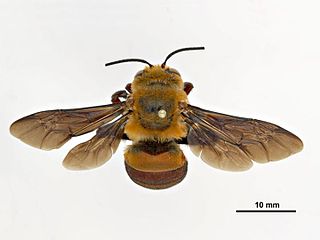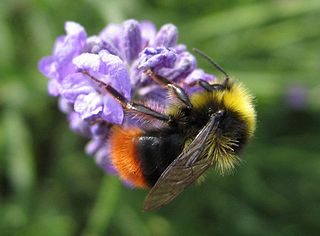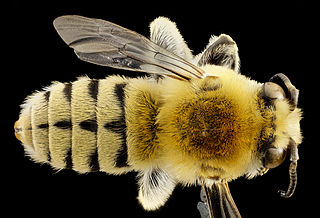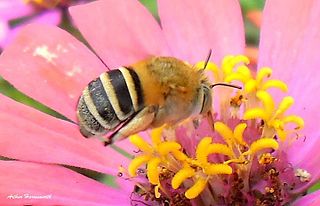
Carpenter bees are species in the genus Xylocopa of the subfamily Xylocopinae. The genus includes some 500 bees in 31 subgenera. The common name "carpenter bee" derives from their nesting behavior; nearly all species burrow into hard plant material such as dead wood or bamboo. The main exceptions are species in the subgenus Proxylocopa, which dig nesting tunnels in suitable soil.

Phalaenopsis, also known as moth orchids, is a genus of about seventy species of plants in the family Orchidaceae. Orchids in this genus are monopodial epiphytes or lithophytes with long, coarse roots, short, leafy stems and long-lasting, flat flowers arranged in a flowering stem that often branches near the end. Orchids in this genus are native to India, Taiwan, China, Southeast Asia, New Guinea and Australia with the majority in Indonesia and the Philippines.

Buzz pollination or sonication is a technique used by some bees, such as solitary bees and bumblebees, to release pollen which is more or less firmly held by the anthers. The anthers of buzz-pollinated plant species are typically tubular, with an opening at only one end, and the pollen inside is smooth-grained and firmly attached. With self-fertile plants such as tomatoes, wind may be sufficient to shake loose the pollen through pores in the anther and accomplish pollination. Visits by bees may also shake loose some pollen, but more efficient pollination of those plants is accomplished by a few insect species who specialize in sonication or buzz pollination.

Hylaeus is a large and diverse cosmopolitan genus within the bee family Colletidae. This genus is also known as the yellow-faced bees or masked bees. This genus is the only truly globally distributed colletid, occurring on all continents except Antarctica.

Australian native bees are a group of bees that play a crucial role in the pollination of native plants. There are over 1,700 species of native bees in Australia, ranging from small solitary bees to the social stingless bees. Native bees are important for native ecosystems, providing pollination services to native plants, and hold value for Australian agriculture.

The cosmopolitan bee genus Ceratina, often referred to as small carpenter bees, is the sole lineage of the tribe Ceratinini, and is not closely related to the more familiar carpenter bees. The genus presently contains over 300 species in 23 subgenera. They make nests in dead wood, stems, or pith, and while many are solitary, a number are subsocial, with mothers caring for their larvae, and in a few cases where multiple females are found in a single nest, daughters or sisters may form very small, weakly eusocial colonies. One species is unique for having both social and asocial populations, Ceratina australensis, which exhibits all of the pre-adaptations for successful group living. This species is socially polymorphic with both solitary and social nests collected in sympatry. Social colonies in that species consist of two foundresses, one contributing both foraging and reproductive effort and the second which remains at the nest as a passive guard. Cooperative nesting provides no overt reproductive benefits over solitary nesting in this population, although brood survival tends to be greater in social colonies. Maternal longevity, subsociality and bivoltine nesting phenology in this species favour colony formation, while dispersal habits and offspring longevity may inhibit more frequent social nesting in this and other ceratinines.

Amegilla cingulata is a species of blue-banded bee native to Australia. Currently, several scientific organizations are conducting research on how A. cingulata benefits agriculture through its distinctive "buzz pollination".

Phalaenopsis pulcherrima is a species of orchid found from Hainan Island to western Malesia.

Thyreus is an Old World genus of bees, one of many that are commonly known as cuckoo bees, or cloak-and-dagger bees, and are kleptoparasites of other species of bees, mostly in the genus Amegilla. They all have strongly contrasting patterns of coloration – three species from the Sydney region, Thyreus nitidulus, T. lugubris, and T. caeruleopunctatus are bright blue and black.

Amegilla bombiformis, commonly known as the teddy bear bee or golden haired mortar bee, is an Australian native bee in the family Apidae.

Amegilla dawsoni, sometimes called the Dawson's burrowing bee, is a species of bee that nests by the thousands in arid claypans in Western Australia. It is a long tongued bee, of the tribe Anthophorini and genus Amegilla, the second largest genus in Anthophorini.

Pyrobombus is a subgenus of bumblebees, with its centres of diversity in Central Asia and north-western North America. Nearly a fifth of all Bombus species fall within Pyrobombus and its member species vary considerably in size, appearance and behaviour. it covers 43 species of bees and is the largest subgenus of bumblebees, covering almost 50% of the North American fauna. They are seen to be declined by 6%, which may be an undervalued statistic, although not as high as other groups of bees. Pyrobombus bees also face issues such as climate change, loss of habitat, urbanization, and industrial agriculture. This subgenus of bees can pollinate which helps plants fertilise and grow fruit that is essential to the biodiversity and life of the environment. Commonly, Pyrobombus bees are used for beekeeping as they are pollinators. They can be for wax, honey, venom, combs, and such which may be collected for commercial use. This subgenus may vary in their characteristics such as body size, wingspan, and tongue length for individual species, but like all bees, they possess wings, a head, thorax, and abdomen.

Ptilothrix is a genus within the tribe Emphorini of the family Apidae. Bees of this genus can range from 7 to 15 mm. Ptilothrix species are solitary, ground-nesting bees. These bees have especially prominent hairs in the scopae of their hind legs, to help gather pollen to provision their nests. Ptilothrix species specialize on certain families of plants for their pollen, including the families Malvaceae, Convolvulaceae, Onagraceae, Cactaceae, Pontederiaceae, and Asteraceae. The genus is found in the New World, with species ranging across the Americas.

Amegilla asserta is a species of bee endemic to Australia, belonging to the family Apidae subfamily Apinae. Females forage by performing buzz pollination.

Habropoda is a genus of anthophorine bees in the family Apidae. There are at least 50 described species in Habropoda.

Amegilla calens is a species of bees in the genus Amegilla. They were first described by Lepeletier in 1841. They are found in several countries in Africa, mainly in the south but as far north as Nigeria.

Amegilla albiceps is a species of bee native to Australia. It has a southern temperate distribution, with records from South Australia and Victoria. A member of the genus Amegilla, it was described in 1951 by Tarlton Rayment. Adults have been found from October to April, and they have been observed visiting flowers of the mistletoe genus Amyema.
Asaropoda is a subgenus of the bee genus Amegilla. It comprises 21 species, and is endemic to Papua New Guinea and mainland Australia. The species within this subgenus range in body length from 12–24 mm.
Zonamegilla is a large subgenus of the bee genus Amegilla. Species of this subgenus can be found throughout Australia, Europe and Asia. Some Zonamegilla are commonly referred to as ‘blue-banded bees,’ however, the abdominal bands can also be orange, green, white or yellow, depending on the species.



















